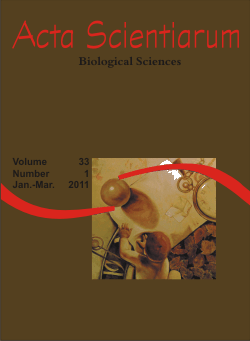<b>Spar genetic analysis of two invasive species of <em>Cichla</em> (Tucunaré) (Perciformes: Cichlidae) in the Paraná river basin</b> - doi: 10.4025/actascibiolsci.v33i1.4855
Keywords:
Hybridization, fish introduction, molecular markers
Abstract
The introduction of exotic species in lake ecosystems has been greatly highlighted in the literature worldwide. Since introduction may threaten diversity of native fish, the issue turns up to be of paramount importance. Ecological effects may be predation, competition, parasitism or genetic, that is, changes in the genetic pool of populations owing to the occurrence of hybrids. Although the Tucunaré fish (Cichla) is native to the Amazon region, it can be found in other hydrographic basins in which it has been introduced. RAPD molecular marker research showed that there are two species (Cichla kelberi and C. piquiti) belonging to the genus Cichla in the rivers of the Paraná basin. Different morphotypes in the region may also be due to hybridization. Current research used SPAR molecular markers to confirm the presence of hybrids and the rupture of isolation mechanisms. Seventy-two specimens collected in several sites of the river Paraná and Amazon basins were analyzed. Since exclusive SPAR molecular markers were obtained for Cichla kelberi and C. piquiti populations, the introduction of the two species in the region has been confirmed. Identification of the markers in specimens of the Paraná river basin confirmed hybridization between these exotic species.Downloads
Download data is not yet available.
Published
2011-02-08
How to Cite
Almeida-Ferreira, G. C., Oliveira, A. V. de, Prioli, A. J., & Prioli, S. M. A. P. (2011). <b>Spar genetic analysis of two invasive species of <em>Cichla</em> (Tucunaré) (Perciformes: Cichlidae) in the Paraná river basin</b> - doi: 10.4025/actascibiolsci.v33i1.4855. Acta Scientiarum. Biological Sciences, 33(1), 79-85. https://doi.org/10.4025/actascibiolsci.v33i1.4855
Issue
Section
Genetics
DECLARATION OF ORIGINALITY AND COPYRIGHTS
I Declare that current article is original and has not been submitted for publication, in part or in whole, to any other national or international journal.
The copyrights belong exclusively to the authors. Published content is licensed under Creative Commons Attribution 4.0 (CC BY 4.0) guidelines, which allows sharing (copy and distribution of the material in any medium or format) and adaptation (remix, transform, and build upon the material) for any purpose, even commercially, under the terms of attribution.
Read this link for further information on how to use CC BY 4.0 properly.
0.6
2019CiteScore
31st percentile
Powered by 

0.6
2019CiteScore
31st percentile
Powered by 











1.png)




3.png)













